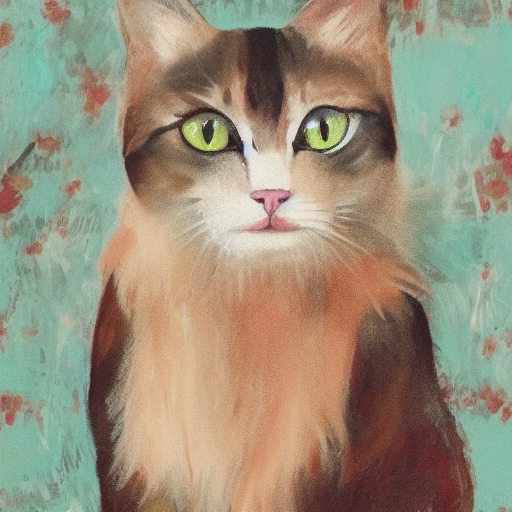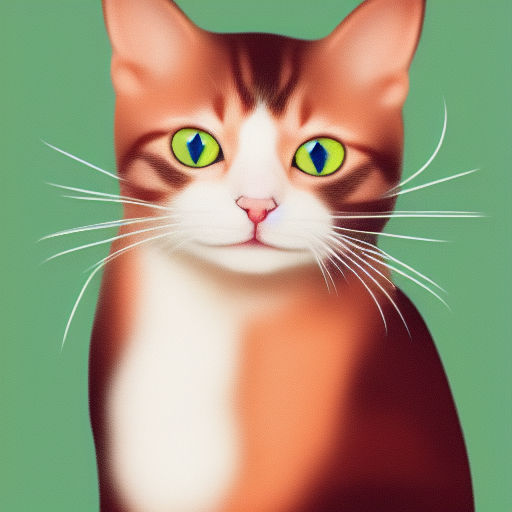
# stable-diffusion.cpp
Inference of [Stable Diffusion](https://github.com/CompVis/stable-diffusion) in pure C/C++
## Features
- Plain C/C++ implementation based on [ggml](https://github.com/ggerganov/ggml), working in the same way as [llama.cpp](https://github.com/ggerganov/llama.cpp)
- 16-bit, 32-bit float support
- 4-bit, 5-bit and 8-bit integer quantization support
- Accelerated memory-efficient CPU inference
- Only requires ~2.3GB when using txt2img with fp16 precision to generate a 512x512 image
- AVX, AVX2 and AVX512 support for x86 architectures
- SD1.x and SD2.x support
- Original `txt2img` and `img2img` mode
- Negative prompt
- [stable-diffusion-webui](https://github.com/AUTOMATIC1111/stable-diffusion-webui) style tokenizer (not all the features, only token weighting for now)
- Sampling method
- `Euler A`
- `Euler`
- `Heun`
- `DPM2`
- `DPM++ 2M`
- [`DPM++ 2M v2`](https://github.com/AUTOMATIC1111/stable-diffusion-webui/discussions/8457)
- `DPM++ 2S a`
- Cross-platform reproducibility (`--rng cuda`, consistent with the `stable-diffusion-webui GPU RNG`)
- Embedds generation parameters into png output as webui-compatible text string
- Supported platforms
- Linux
- Mac OS
- Windows
- Android (via Termux)
### TODO
- [ ] More sampling methods
- [ ] GPU support
- [ ] Make inference faster
- The current implementation of ggml_conv_2d is slow and has high memory usage
- [ ] Continuing to reduce memory usage (quantizing the weights of ggml_conv_2d)
- [ ] LoRA support
- [ ] k-quants support
## Usage
### Get the Code
```
git clone --recursive https://github.com/leejet/stable-diffusion.cpp
cd stable-diffusion.cpp
```
- If you have already cloned the repository, you can use the following command to update the repository to the latest code.
```
cd stable-diffusion.cpp
git pull origin master
git submodule init
git submodule update
```
### Convert weights
- download original weights(.ckpt or .safetensors). For example
- Stable Diffusion v1.4 from https://huggingface.co/CompVis/stable-diffusion-v-1-4-original
- Stable Diffusion v1.5 from https://huggingface.co/runwayml/stable-diffusion-v1-5
- Stable Diffuison v2.1 from https://huggingface.co/stabilityai/stable-diffusion-2-1
```shell
curl -L -O https://huggingface.co/CompVis/stable-diffusion-v-1-4-original/resolve/main/sd-v1-4.ckpt
# curl -L -O https://huggingface.co/runwayml/stable-diffusion-v1-5/resolve/main/v1-5-pruned-emaonly.safetensors
# curl -L -O https://huggingface.co/stabilityai/stable-diffusion-2-1/blob/main/v2-1_768-nonema-pruned.safetensors
```
- convert weights to ggml model format
```shell
cd models
pip install -r requirements.txt
python convert.py [path to weights] --out_type [output precision]
# For example, python convert.py sd-v1-4.ckpt --out_type f16
```
### Quantization
You can specify the output model format using the --out_type parameter
- `f16` for 16-bit floating-point
- `f32` for 32-bit floating-point
- `q8_0` for 8-bit integer quantization
- `q5_0` or `q5_1` for 5-bit integer quantization
- `q4_0` or `q4_1` for 4-bit integer quantization
### Build
#### Build from scratch
```shell
mkdir build
cd build
cmake ..
cmake --build . --config Release
```
##### Using OpenBLAS
```
cmake .. -DGGML_OPENBLAS=ON
cmake --build . --config Release
```
### Run
```
usage: ./bin/sd [arguments]
arguments:
-h, --help show this help message and exit
-M, --mode [txt2img or img2img] generation mode (default: txt2img)
-t, --threads N number of threads to use during computation (default: -1).
If threads <= 0, then threads will be set to the number of CPU physical cores
-m, --model [MODEL] path to model
-i, --init-img [IMAGE] path to the input image, required by img2img
-o, --output OUTPUT path to write result image to (default: .\output.png)
-p, --prompt [PROMPT] the prompt to render
-n, --negative-prompt PROMPT the negative prompt (default: "")
--cfg-scale SCALE unconditional guidance scale: (default: 7.0)
--strength STRENGTH strength for noising/unnoising (default: 0.75)
1.0 corresponds to full destruction of information in init image
-H, --height H image height, in pixel space (default: 512)
-W, --width W image width, in pixel space (default: 512)
--sampling-method {euler, euler_a, heun, dpm++2m, dpm++2mv2}
sampling method (default: "euler_a")
--steps STEPS number of sample steps (default: 20)
--rng {std_default, cuda} RNG (default: cuda)
-s SEED, --seed SEED RNG seed (default: 42, use random seed for < 0)
-v, --verbose print extra info
```
#### txt2img example
```
./bin/sd -m ../models/sd-v1-4-ggml-model-f16.bin -p "a lovely cat"
```
Using formats of different precisions will yield results of varying quality.
| f32 | f16 |q8_0 |q5_0 |q5_1 |q4_0 |q4_1 |
| ---- |---- |---- |---- |---- |---- |---- |
|  | | | | | | |
#### img2img example
- `./output.png` is the image generated from the above txt2img pipeline
```
./bin/sd --mode img2img -m ../models/sd-v1-4-ggml-model-f16.bin -p "cat with blue eyes" -i ./output.png -o ./img2img_output.png --strength 0.4
```

### Docker
#### Building using Docker
```shell
docker build -t sd .
```
#### Run
```shell
docker run -v /path/to/models:/models -v /path/to/output/:/output sd [args...]
# For example
# docker run -v ./models:/models -v ./build:/output sd -m /models/sd-v1-4-ggml-model-f16.bin -p "a lovely cat" -v -o /output/output.png
```
## Memory/Disk Requirements
| precision | f32 | f16 |q8_0 |q5_0 |q5_1 |q4_0 |q4_1 |
| ---- | ---- |---- |---- |---- |---- |---- |---- |
| **Disk** | 2.7G | 2.0G | 1.7G | 1.6G | 1.6G | 1.5G | 1.5G |
| **Memory**(txt2img - 512 x 512) | ~2.8G | ~2.3G | ~2.1G | ~2.0G | ~2.0G | ~2.0G | ~2.0G |
## References
- [ggml](https://github.com/ggerganov/ggml)
- [stable-diffusion](https://github.com/CompVis/stable-diffusion)
- [stable-diffusion-stability-ai](https://github.com/Stability-AI/stablediffusion)
- [stable-diffusion-webui](https://github.com/AUTOMATIC1111/stable-diffusion-webui)
- [k-diffusion](https://github.com/crowsonkb/k-diffusion)


